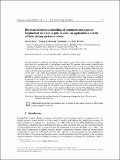Files in this item
Bayesian hierarchical modelling of continuous non-negative longitudinal data with a spike at zero : an application to a study of birds visiting gardens in winter
Item metadata
| dc.contributor.author | Swallow, Benjamin Thomas | |
| dc.contributor.author | Buckland, Stephen Terrence | |
| dc.contributor.author | King, Ruth | |
| dc.contributor.author | Toms, Mike | |
| dc.date.accessioned | 2015-03-03T14:31:02Z | |
| dc.date.available | 2015-03-03T14:31:02Z | |
| dc.date.issued | 2016-03 | |
| dc.identifier | 146315813 | |
| dc.identifier | 4f3df57d-b8ec-419f-af62-b662a8a2b9a2 | |
| dc.identifier | 84959198866 | |
| dc.identifier | 000372174400007 | |
| dc.identifier.citation | Swallow , B T , Buckland , S T , King , R & Toms , M 2016 , ' Bayesian hierarchical modelling of continuous non-negative longitudinal data with a spike at zero : an application to a study of birds visiting gardens in winter ' , Biometrical Journal , vol. 58 , no. 2 , pp. 357-371 . https://doi.org/10.1002/bimj.201400081 | en |
| dc.identifier.issn | 0323-3847 | |
| dc.identifier.other | ORCID: /0000-0002-9939-709X/work/73701036 | |
| dc.identifier.other | ORCID: /0000-0002-0227-2160/work/118411947 | |
| dc.identifier.uri | https://hdl.handle.net/10023/6164 | |
| dc.description.abstract | The development of methods for dealing with continuous data with a spike at zero has lagged behind those for overdispersed or zero‐inflated count data. We consider longitudinal ecological data corresponding to an annual average of 26 weekly maximum counts of birds, and are hence effectively continuous, bounded below by zero but also with a discrete mass at zero. We develop a Bayesian hierarchical Tweedie regression model that can directly accommodate the excess number of zeros common to this type of data, whilst accounting for both spatial and temporal correlation. Implementation of the model is conducted in a Markov chain Monte Carlo (MCMC) framework, using reversible jump MCMC to explore uncertainty across both parameter and model spaces. This regression modelling framework is very flexible and removes the need to make strong assumptions about mean‐variance relationships a priori. It can also directly account for the spike at zero, whilst being easily applicable to other types of data and other model formulations. Whilst a correlative study such as this cannot prove causation, our results suggest that an increase in an avian predator may have led to an overall decrease in the number of one of its prey species visiting garden feeding stations in the United Kingdom. This may reflect a change in behaviour of house sparrows to avoid feeding stations frequented by sparrowhawks, or a reduction in house sparrow population size as a result of sparrowhawk increase. | |
| dc.format.extent | 15 | |
| dc.format.extent | 457499 | |
| dc.language.iso | eng | |
| dc.relation.ispartof | Biometrical Journal | en |
| dc.subject | Bayesian hierarchical model | en |
| dc.subject | Continuous nonnegative data | en |
| dc.subject | Excess zeros | en |
| dc.subject | Tweedie distributions | en |
| dc.subject | QA Mathematics | en |
| dc.subject | QH301 Biology | en |
| dc.subject | NDAS | en |
| dc.subject | BDC | en |
| dc.subject | R2C | en |
| dc.subject.lcc | QA | en |
| dc.subject.lcc | QH301 | en |
| dc.title | Bayesian hierarchical modelling of continuous non-negative longitudinal data with a spike at zero : an application to a study of birds visiting gardens in winter | en |
| dc.type | Journal article | en |
| dc.contributor.sponsor | EPSRC | en |
| dc.contributor.institution | University of St Andrews. School of Mathematics and Statistics | en |
| dc.contributor.institution | University of St Andrews. Scottish Oceans Institute | en |
| dc.contributor.institution | University of St Andrews. Centre for Research into Ecological & Environmental Modelling | en |
| dc.contributor.institution | University of St Andrews. Marine Alliance for Science & Technology Scotland | en |
| dc.contributor.institution | University of St Andrews. St Andrews Sustainability Institute | en |
| dc.identifier.doi | https://doi.org/10.1002/bimj.201400081 | |
| dc.description.status | Peer reviewed | en |
| dc.identifier.grantnumber | EP/I000917/1 | en |
This item appears in the following Collection(s)
Items in the St Andrews Research Repository are protected by copyright, with all rights reserved, unless otherwise indicated.

